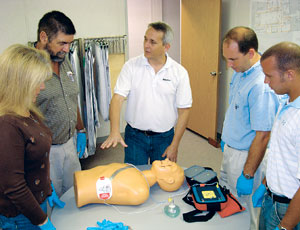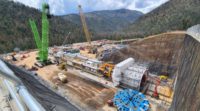Trying hard to hang onto its valuable construction workforce, at least one contractor has launched a new jobsite-wide health and safety measure: deployment of automated external defibrillators (AEDs) to revive sudden heart attack victims at all of its U.S. and Caribbean project sites.

While AEDs have found their way into more workplaces and other public spaces, executives of Moss & Associates LLC and other heart-attack prevention professionals believe the Fort Lauderdale-based building contractor could be the first industry firm to widely deploy the devices and extensively train workers in their use. Experts say AEDs can increase the survival rates of cardiac arrest victims by up to 85%.
While there are no accurate statistics, industry observers say construction’s labor force tends to be older and is part of a high-stress business that often has other risk factors such as smoking and poor diet. Such factors make a person prone to sudden cardiac arrest. Up to 300,000 people a year suffer sudden heart attacks, with a 5% or less survival rate, reports the American Heart Association.
The problem can be compounded at remote jobsites that are difficult for emergency response personnel to respond quickly. After a heart attack, the chance of survival drops 7% to 10% every minute a person is not defibrillated, says Barbara Caracci, the National Safety Council’s director of program development and training for emergency care programs.
“This AED initiative is an important component of our proactive approach that focuses on anticipating the location and timing of emergencies on the jobsite,” says Bob Moss, president of the firm, which ranks 95th on ENR’s list of the Top 400 contractors, with nearly $650 million in 2007 revenue. The firm has deployed the devices, which provide an electric charge that restores interrupted heart function and blood flow, at 30 jobsites since August, spending an estimated $65,000, says the firm’s safety manager, Scott Gerard.
While Moss is Florida’s second-largest contractor whose projects include large prisons and a new stadium for the Florida Marlins baseball team, “we’re putting AEDs on the smallest of jobs,” says Gerard. The firm aims to train 150 site personnel in their use, using simulated training devices and a safety council curriculum, he adds.
Gerard says AED users must already be certified in CPR.“There are so many hazards on a construction site,” says Gerard. “This was a natural thing to do.” He notes that even “the most timid employees” have tried AED training techniques using the lightweight devices on mannequins. Jamie Froman, marketing director for Philips Healthcare, the Seattle-based supplier of the devices to Moss, says four hours of training can be sufficient.
So far, Moss employees have not yet had to use AEDs for real cardiac emergencies on site, says Gerard. “But I’ve been on other jobsites where they weren’t there and the heart-attack victim did not survive,” he adds. The safety manager says he knows of no other construction firm that has deployed AEDs to all sites, but he says he is fielding more phone calls from company safety managers and industry associations.
AEDs generally cost from $1,200 for basic models to $3,000, with training extra, says Froman, claiming that Philips has supplied the devices to about 85% of the Fortune 100 list of companies. He notes Chicago O’Hare airport, the Rochester, Minn., police force and a number of Las Vegas casinos as major AED users, but the devices are still in less than 15% of workplaces, he estimates.
“Our investment will have been well worth it, if we can save just one life,” says Gerard. “You can replace equipment, but not people.”





Post a comment to this article
Report Abusive Comment